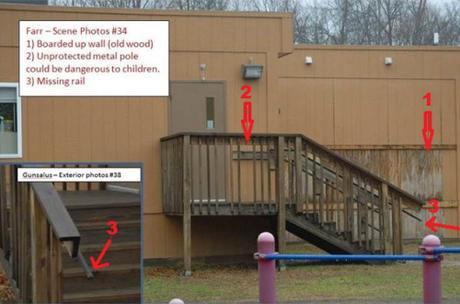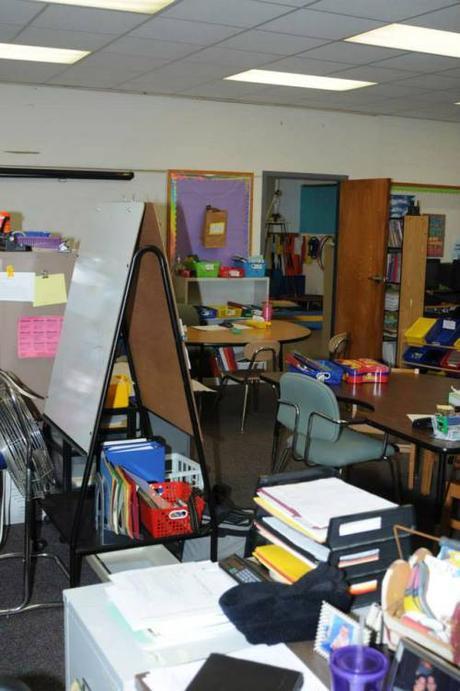The alternative media have blogged and made countless YouTube videos on what Wolfgang Halbig calls "things that don't make sense" about the Sandy Hook Elementary School (SHES) shooting massacre of 20 first-graders and 6 adults on December 14, 2012, in Newtown, Connecticut.
Some of those "things that don't make sense" are emergency medical helicopters not being called to the scene, parents showing no grief, donation websites with creation dates that preceded the massacre, government's continuing refusal to release the death certificates and burial sites of the alleged victims, and homes with a sale transaction date of 12/25/2009 and a $0 sale price.
Recently, I undertook a review of the "things that don't makes sense," which led me to conclude that the crux - the decisive and most important issue - of whether the massacre actually happened is this:
Was Sandy Hook Elementary School (SHES) operational on December 14, 2012, or had it long been abandoned?
If the school already was closed, no children or teachers would be there on December 14 to be gunned down by Adam Lanza.
Here's the evidence supporting the contention that SHES had long been abandoned:
1. What school's neighbors said
In an interview with Halbig on Truth Radio Show on March 21, 2014, Infowars reporter Dan Bidondi said (5:45 mark), "The school's been closed down for God knows how long. [Neighbors] can't understand why there were kids in that building because it was condemned."
2. Reports of SHES being contaminated with asbestos, requiring expensive repairs
SHES was built in 1956. Several reports in local newspaper The Newtown Bee indicate that years before the massacre, SHES was in a state of disrepair and contaminated with environmental toxins.
As examples, , Consulting Engineering Services recommended to the school district that SHES be "worked on in 2010 over a nine-month period" to upgrade and renovate its heating and ventilation system at a cost of $4.5 million.Two years later, , the Newtown Board of Education was told "there were serious problems with the Sandy Hook elementary school roof." Four years later, , there was yet more bad news: SHES was contaminated with asbestos. (Remember that 2008 date.)
On October 5, 2013, nearly 10 months after the massacre, a city referendum passed by over 90% in support of the demolition and rebuilding of SHES with a generous $49.25 million grant from the State of Connecticut. The reason given for the demolition was "asbestos abatement". On , Newtown's Public Building and Site Commission Chairman Robert Mitchell issued a report to justify the already-approved demolition. He said that "had the town decided to reoccupy the school on Dickinson Drive, it would have faced a daunting and possibly insurmountable regarding the presence of hazardous materials" because the school was contaminated by not just asbestos, but also PCBs under the flooring and in the foundations and footings.
Just think: If the city already knew in 2008 that the school was contaminated with asbestos and, in 2013, used the contamination to justify tearing it down, why would the same asbestos-contaminated school be safe for children and teachers to inhabit from 2008 through 2012? If SHES had remained open, wouldn't the school district be sued for endangering public health?
It makes more sense that the school was shut down in 2008 and remained closed, until the massacre provided Newtown with the financial means - a windfall of $50 million from the state - to tear down the school and build a swanky, state-of-the-art replacement.

3. Photographic evidence of an abandoned school
Crime scene photos of the exterior and interior of SHES - from the website of the State of Connecticut's Department of Emergency Services and Public Protection, and from a batch of photos that Halbig obtained via Connecticut's Freedom of Information Act (FOIA), some of which are posted on James Fetzer's blog - are consistent with the appearance of an abandoned school.
Moss and grime covered the school building; repairs were left undone. Especially noteworthy, as pointed out , is a dangerous, exposed metal rod on an exterior staircase (see #3 in photo below):

Classrooms and hallways were used for storage, jammed with furniture and office supplies. If those rooms and hallways were actually in an operational school, then SHES was in clear violation of the fire safety code.


Then there is this photo of a pile of dust underneath an alleged bullet hole in a wall outside Room 1C, which looks suspiciously like the debris from someone drilling a pretend "bullet" hole into the ceramic wall-tile.
4. Absence of Internet activity 2008-2013
Arguably, the most compelling evidence that SHES had long been abandoned before the 2012 massacre is the testimony from the Internet Archive's Wayback Machine of the school's lack of of Internet activity from the beginning of 2008 through all of 2012.
The Wayback Machine is a digital archive of the Internet which uses a special software to crawl and download all publicly accessible World Wide Web pages. It was Jungle Server who first discovered that the Wayback Machine shows an absence of Internet activity from SHES since 2008 - the same year when the school was found to be contaminated with asbestos.
To verify Jungle Surfer's claim, I searched for SHES's website, http://newtown.k12.ct.us/~sh, on the Wayback Machine, the result of which is below, showing the school's lack of Internet activity from the beginning of 2008 to mid-2013. By mid-2013, we are told SHES temporarily had relocated to the nearby town of Monroe, about 9 miles from Newtown. You are invited to replicate and verify what I did by going here.

5. Halbig's FOI Hearing
On April 24, 2015, more than two years after Halbig first asked questions about Sandy Hook by phoning and writing letters to Connecticut officials invoking the FOIA, the state finally granted him the first of two hearings before the State of Connecticut Freedom of Information Commission. The respondents were the Newtown Police Department, First Selectman Patricia Llodra, the Town of Newtown, and Newtown's Board of Education. They were represented by attorney Monte Frank, a gun-control activist who founded Team 26, a cycling group that lobbies for gun control.
The purpose of the hearing was to determine if Newtown improperly withheld documents requested by Halbig. Halbig claims that he had the following documents from the respondents, but was denied - the denial being a violation of FOIA:
- SHES maintenance work orders, including:
- Copies of all maintenance work orders submitted by SHES principal Dawn Hochsprung (one of Lanza's alleged victims who, strangely, was interviewed by The Bee about the massacre) or her designee to the school district maintenance department for any repairs, new classroom doors or painting from July 1, 2012 through December 13, 2012.
- Copies signed by Hochsprung or her designee showing the date of completion of the repairs together with time stamps showing job completion.
- Copies of all emails to and from Hochsprung and her assistant to various school district departments, e.g., food services provider, from May 1, 2012 through December 13, 2012.
The requested documents presumably could prove that the school was operational on the day of the massacre.
In a post on April 25, 2015, an anonymous contributor to SandyHookFacts.com, a blog that claims to debunk Sandy Hook "conspiracy theorists," triumphantly crowed that the FOI hearing was a "total failure" for Halbig because attorney Frank said time-stamped SHES maintenance work orders signed by Hochsprung or her designee had been made available to Halbig six months before the hearing.
SandyHookFacts.com is much too hasty and mistaken in its crowing for in a memo on June 25, 2015, titled " Transmittal of Proposed Final Decision," the State of Connecticut Freedom of Information Commission (FOIC) states the following:
"it is found that the respondents, through counsel, informed the complainant [Halbig] that the respondents maintained 45 records responsive to the complainant's request described in paragraph 2(a)(i), above, and that they would be provided upon payment of the copying fee. [...]
It is found that the respondents' counsel also informed the complainant that his request described in paragraph 2(a)(i) , above, was vague, overly broad, and that it was not a request for 'specific documents and would require research and analysis not required under the FOI Act. '"
Most importantly, the FOIC states:
"It is found that . . . the respondents, through counsel, also informed the complainant that the town had no records responsive to the request described in paragraph 2(a)(ii) , above."
Note that paragraph 2(a)(i) in the FOIC memo is 1A in this post (see above), i.e., copies of all maintenance work orders submitted by SHES principal Dawn Hochsprung or her designee to the school district maintenance department for any repairs, new classroom doors or painting from July 1, 2012 through December 13, 2012.
Note that paragraph 2(a)(ii) in the FOIC memo is 1B in this post , i.e., copies signed by Hochsprung or her designee showing the date of completion of the repairs together with time stamps showing job completion.
By saying that "the town had no records responsive to the request described in paragraph 2(a)(ii)," the FOIC means the town of Newtown does not have documents signed by Hochsprung or her designee showing the date of completion of the repairs [to SHES] together with time stamps showing job completion.
Furthermore, the FOIC memo also states:
"It is found that the respondents' counsel also informed the complainant that his request described in paragraph 2(b)(i), above, was vague, overly broad, and that it . . . 'would require research and analysis not required under the FOI Act.'"
Note that FOIC's paragraph 2(b)(i) is document 2 in this post , i.e., copies of all emails to and from Hochsprung and her assistant to various school district departments, e.g., food services provider, from May 1, 2012 through December 13, 2012.
In other words, Newtown cannot produce evidence that repairs were made on Sandy Hook Elementary School or any email from Hochsprung to school district departments in the months preceding the massacre from May 1, 2012 through December 13, 2012.The reason is a simple one: the school was not operational, having been closed down for years, most probably since 2008 when it was discovered to be contaminated with asbestos.
Go to our " Sandy Hook Massacre" page for links to other posts on this hoax.

